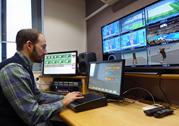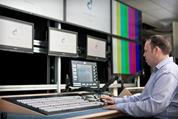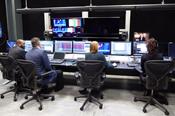Broadcast Systems Integration Trends |
Some decades ago, the opinion was expressed by an industry veteran that television broadcasters should climb the ladder up to higher technical standards as quickly as possible because they had the computer business snapping at their feet. But it ignored the reality that the computer industry embraces new technology so quickly that the word 'standards' seems almost irrelevant. The computer world is essentially resolution independent, upscaling or downscaling to whatever display format is most appropriate to the host device. The broadcast industry is heading in the same direction with SD, HD and UHD co-existing on a wide range of devices.
SD images transcode very nicely up to UHD when viewed from a respectable distance. HD images transcode to UHD even better. And UHD source material can look breathtaking when viewed close up. So who is pushing for higher standards and why? It certainly isn't the systems integrators; our role is to deliver what the customer needs in today's marketplace while leaving the door open to add new facilities or new channels in line with future demand. The push for higher standards comes from relentless advances in electronics. With every passing year, components can be made smaller, faster and (provided the market is large enough) cheaper. This leads in turn to improved cameras, faster signal processors, greater memory capacity and improved displays. We are already working in the UHD domain, for a client who recognises that shooting in UHD is a sure way to prolong the commercial life of new productions. NHK has long advocated pushing the UHD boundary out to 3840 x 2160 pixels. This has become the next production target for consumer display manufacturers with their eyes firmly focused on the 2020 Tokyo Olympics.
Meanwhile the push is on for higher dynamic range. Latest generation OLED screens achieve subjectively greater visual dynamic range than the majority of LED-backlit LCDs. The reason is simply that each pixel in an OLED generates its own light rather acting as a filter for light coming from behind it. The result is greatly improved handling of dark areas. Since OLEDs can also generate impressively bright images, the perceived picture quality can be breathtaking. There are still standards issues to be settled in relation to video dynamic range, complicated by the variety of methods available for transcoding and screen refreshing. The move from panel-per-product hardware to software-based solutions running on enterprise servers has now become an established fact of systems integration life. Technology has progressed to the point where multiple devices can be virtualised within a single server. The key technical challenge today is to ensure that software from multiple vendors operates efficiently when combined into a single operating environment, whilst retaining the flexibility and reliability that broadcasters quite rightly insist on. There was a lot of discussion at the trade shows in 2014 and 2015 about the relative merits of SDI and IP. IP clearly has some benefits on offer but there are still plenty of reasons why we will see the continued use of SDI for the foreseeable future. Rather than IP completely replacing SDI, it is evident that a hybrid approach currently offers the best of both technologies.
Traditional broadcasting has proved its ability not just to survive competition from the computer industry but to embrace it. Many channels now offer catch-up television services as a routine element of their activity, along with web-based news, programme guides and over-the-top supplementary programme feeds. A key element of our role as a systems integrator is to support our customers with these new delivery options and to ensure they can operate as efficiently as possible in an industry which demands high productivity as well as creativity. |



